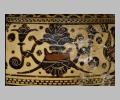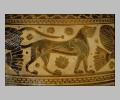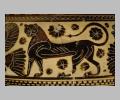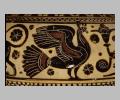| Collection: | University Museum, University of Pennsylvania |
| Summary: | A single frieze of animals between ornamental bands. |
| Ware: | Corinthian |
| Painter: | Attributed to the Geladakis Painter |
| Date: | ca. 595 BC - ca. 570 BC |
| Dimensions: | H. 0.093 m., H. with lid 0.119 m., D. 0.164 m. |
| Primary Citation: | |
| Shape: | Pyxis |
| Ceramic Phase: | Middle Corinthian |
| Period: | Archaic |
Condition:
There are small chips in the rim and the lower half of the body. There are some salt deposits on the surface, and the surface of the handle is worn.
Decoration Description:
Continuous animal frieze. A siren with wings spread forms the focus of the frieze on one side, since all the animals turn towards her. The siren faces right and is shown with body and wings in three-quarters profile, head and tail in profile. Added red decorates her wings, tail and breast. She is flanked by griffin birds with curled wings. Panthers stand behind each of the birds. Opposite the siren is a lotus-palmette with an attached upright bud on each side. It is flanked by griffin birds with raised wings. Filling motifs of dots, blobs and small and large incised rosettes cover the field.
Shape Description:
A convex handleless pyxis with lid, having a depressed globular body on a wide conical foot.
Collection History:
The vase was purchased by the University Museum, Philadelphia, in 1918.
Sources Used:
Other Bibliography:





